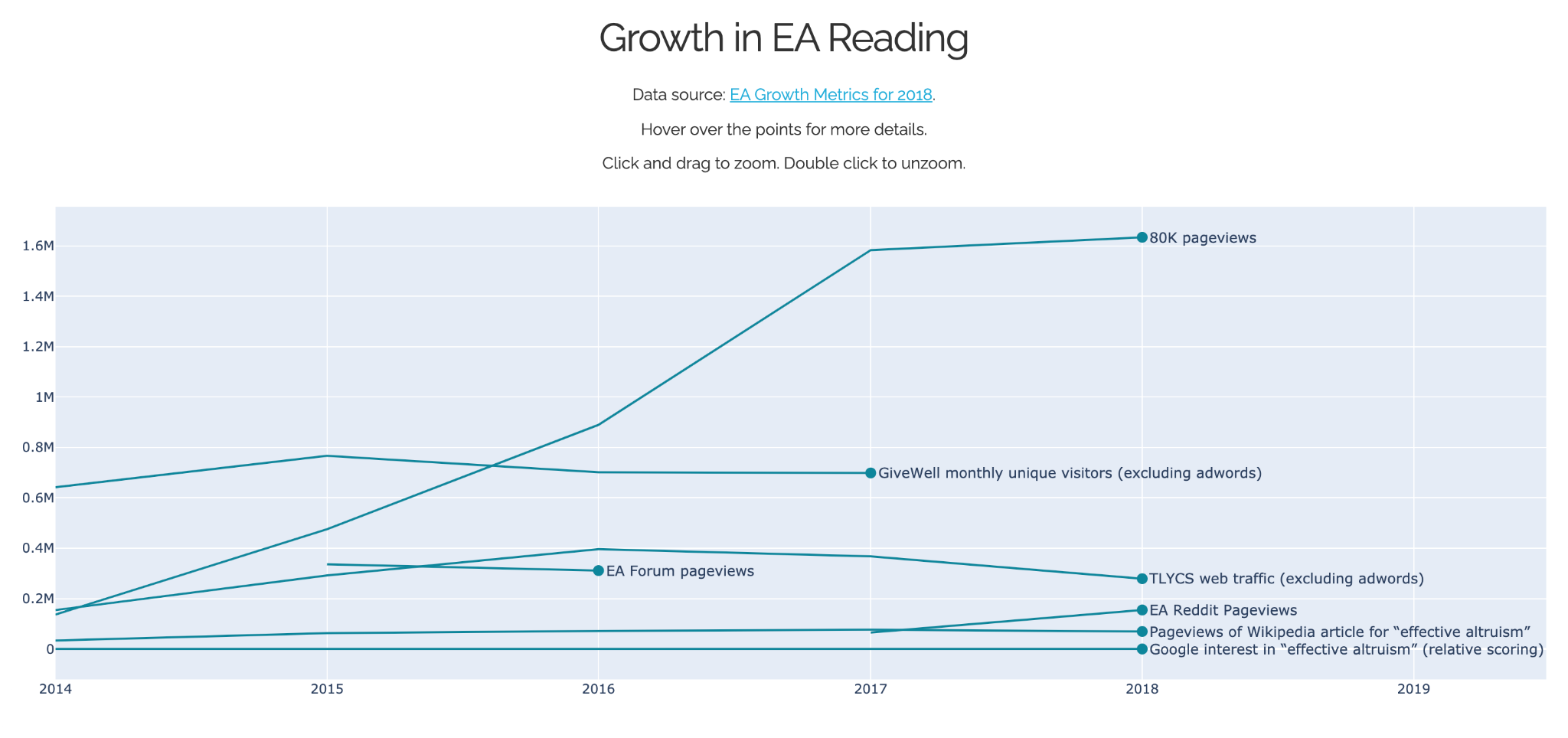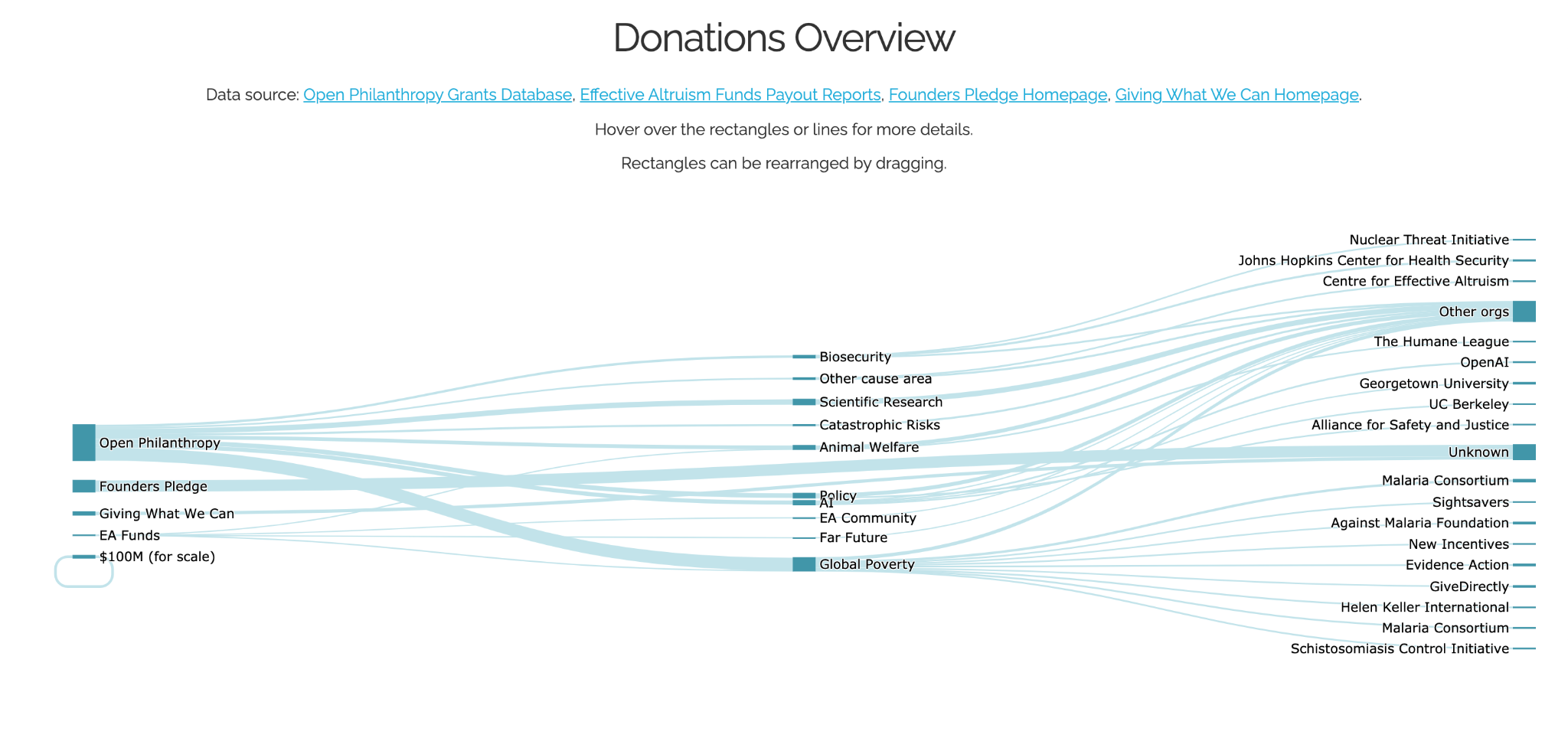There’s lots of cool data floating around in EA: grant databases, survey results, growth metrics, etc. I’m a data scientist and enjoy data visualisation, so thought it would be a fun project to build a website which aggregates EA data into interactive plots.
The website is now live at EffectiveAltruismData.com. Source code is available on Github.
This project is still a work in progress: the data is pretty out of date and I’ve got lots of future work planned. But it’s far enough along that I’d like some public feedback.
The website is responsive and should look good on any desktop or tablet screen. If you’re viewing on a phone it will probably look ok, but you may need to alternate between portrait and landscape.
Here are a few screenshots:



Implementation Details
The website is mostly coded in Python. The main libraries I used were:
- Pandas for data handling.
- Plotly for creating the interactive plots.
- Dash for the web framework.
I also wrote a bunch of vanilla CSS for the frontend styling.
The web server is currently deployed with Heroku, which costs $7/month.
I have vague ambitions to re-implement the frontend with D3.js or Chart.js. This should cut down the loading time and give me more control over how the visualisations work.
Design Philosophy
I aimed to follow the data visualisation principles laid out in Information Dashboard Design and Storytelling with Data. These include:
- Minimise the “ink-to-data” (or “pixel-to-data”) ratio to avoid distracting clutter.
- Encoding data in length or distance is much higher fidelity than area or angle.
- Avoid pie charts, stacked area plots, radar charts, violin plots.
- Stick to bar charts, scatter plots, and line graphs as much as possible.
- Don’t make the reader rotate their head.
- Use horizontal bar charts rather than vertical ones.
- Minimise the total length the eye has to travel to take in all the data.
- Avoid legends.
- On line graphs, put the labels directly on the ends of the lines.
Why I Did This
I said earlier that this project was motivated by my fancy for data visualisation. But I do think there’s a lot of scope for valuable data visualisation and data wrangling work within Effective Altruism.
For example, I’ve found it difficult to get a sense of the scale of donations within EA. Are total donations basically Open Philanthropy plus a rounding error? Or do donations from all the little guys like me actually make a difference in the big picture?
This isn’t just an interesting question in itself: it also informs my life decisions. If the total donations of people in my reference class is enough to make a noticeable change to AMF funding, then I’m more likely to steadily earn-to-give on a moderately affluent career path. If my reference class is totally overwhelmed by a handful of mega-donors, then I’m more likely to drop everything and spend a year figuring out if I can contribute to AI safety.
This was some of the motivation behind the first panel of EffectiveAltruismData.com. Ultimately, I’d like to have a plot which puts all the major stocks and flows of EA money on a common scale and puts my personal earning-to-give into perspective.
Another example: I have a vague sense that EAs are getting more diverse over time. Is this true? Currently, answering this question would require going through all the EA survey reports, reading numbers from images of plots, and typing them into a spreadsheet. It would be nice if all the data was easily accessible from some central repository and ready for analysis.
Data visualisation is a great tool for getting lots of people quickly up to speed on quantitative facts. Gapminder and Our World in Data do this to great effect. If we want EA to be an efficient machine for turning smart people into utils, then we should make full use of data visualisation’s affordances.
This Took Surprisingly Long
I started this project in June last year, a full 14 months ago. This is why the survey data is from 2019. The git repository has about 170 commits. I reckon each commit represents somewhere between 10 minutes and one hour of work, so I think I’ve spent something like 50-100 hours on this so far.
The website isn’t super complicated. Why did it take so long?
For one thing I wasn’t very good at staying focused and making steady progress until Ivan agreed to be my boss for this project and check in on my progress every week. Thanks Ivan!
Other protracting factors include:
- Putting this data together required web scraping, exchanging emails, manually typing out numbers from images of tables, correcting typos, and standardising terminology across data sets.
- The Dash API is kind of a pain. It took me so long to figure out how to customise hover text on bar charts.
- My goal changed several times throughout the project. First I was going to make a dashboard like the Johns Hopkins one, but with Effective Altruism instead of COVID. But I couldn’t pack all the data into a single screen, so I broke it up into sections with 4-6 plots each. But it was still hard to arrange all the plots harmoniously, so in the end I limited myself to having one or two plots on the screen at a time.
- There are many tiny decisions which go into each plot. How big do I make the font? Do I leave long labels as they are, or abbreviate them? What order should the bars go in? Each plot needs dozens of iterations before I can settle on answers to these questions.
Future work
A sample from my todo list:
- Make a line plot of cumulative grants from Open Philanthropy (for each focus area individually and in total).
- Do all the same plots I have for Open Philanthropy for EA Funds as well.
- Put a navigation bar on the side.
- Extract the data from the 2020 EA Survey report.
At a higher level, I’m also thinking about spinning off a Python library for using EA data so that anyone who wants to do any analysis doesn’t have to worry about the arduous data collection process.
And as mentioned earlier, I have vague ambitions to re-implement the plots using D3.js or Chart.js to avoid backend hosting costs and to improve performance.
Request for Feedback
I intend to apply for an EA Funds grant to work full time on building a central repository of EA data with a visualisation frontend. If you might benefit from having better access to EA data, data visualisations, or data analysis, please drop a comment to let me know. If it’s crickets out there then maybe I shouldn’t be spending resources on this.
Examples of feedback which would help:
- What do you like or dislike about EffectiveAltruismData.com?
- Are there any data you’d like to see aggregated or compared?
- Are there any plots you’d like enhanced with interactivity?
- Have you got any data you can give me?
Thanks
Thanks to Ivan Burduk for volunteering to be my boss for this project.
Thanks to David Moss for help with the EA Survey data.
Thanks to Mac Jordan for helping get this project off the ground. The first few sessions of work on this were largely excuses to hang out with Mac.

That's beautiful! Thanks for creating the website and for this interesting writeup :)
Hey, can you manage the project on github and, like, make issues and break up the stuff you have planned into chunks? That way, people can help out with stuff if they have time. Or maybe you can look for someone else who is interested in working on this?
Thanks for the suggestion. I don't have a super clear idea of what the main issues/chunks actually are at the moment, but I'll work towards that.
Awesome work! I remember when Ivan mentioned your project to me. Really cool to see it come to fruition. I like the idea of a central data repository and would benefit from it. I think that having an accompanying visualisation like this could add value to the annual EA survey data.
I also think that creating data visualisations could also help to increase the dissemination and impact of EA research. I'd like to see more work there too.
Great stuff! Can one use the graphics in articles / blogposts, what is the licensing?
Very exciting! In case funding would help with further developing this project, consider applying here, our process is designed to be fast and easy.
Edit: Ah, I can see that you mention this in your post - we're looking forward to receiving your application!
Thanks to Hamish for also helping me with some of the parsing in moving content from the dynamic document (Rmd/Bookdown) here into the EA forum format for the EAS donations post here.
I hope we can continue to work to develop tools to integrate data visualization and dynamic document formats into the EA forum.
This is very cool! I share your view that comprehensive data is an important part of my personal e2g decision-making (and can be difficult to find).
If you haven't seen it already, this recent post by Ben Todd is probably the best source I know of as far as resource allocation.
I made a rough attempt to this effect earlier this year (there you can also find a link to the source code).
Oh, great! Your post looks very helpful!
This is truly awesome!! Adding to upcoming EA Software Engineers newsletter.
This is awesome. Thank you for creating this!